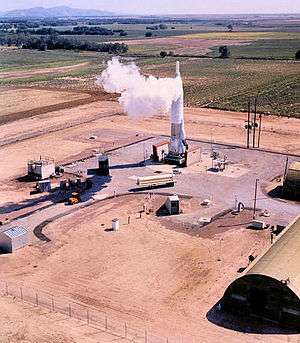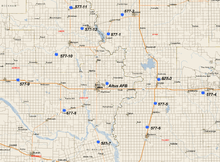577th Strategic Missile Squadron
The 577th Strategic Missile Squadron is an inactive United States Air Force unit. It was last assigned to the 11th Strategic Aerospace Wing, stationed at Altus Air Force Base, Oklahoma.
| 577th Strategic Missile Squadron | |
|---|---|
 Convair SM-65F Atlas No. 56, Site 11 Willow OK | |
| Active | 1943–1949; 1961–1965 |
| Country | United States |
| Branch | |
| Type | Squadron |
| Role | Intercontinental ballistic missile |
| Garrison/HQ | Altus AFB, Oklahoma |
| Engagements | World War II (EAME Theater) |
| Decorations | Distinguished Unit Citation |
| Insignia | |
| 577th Strategic Missile Squadron emblem |  |
On 1 July 1961, the 577th Strategic Missile Squadron (ICBM-Atlas) went on alert as a Strategic Air Command intercontinental ballistic missile squadron, being equipped with the SM-65F Atlas, with a mission of nuclear deterrence.
The squadron was inactivated as part of the phaseout of the Atlas ICBM on 25 March 1965.
History
World War II
Established as a B-24 Liberator heavy bomber squadron; trained under Second Air Force. Deployed to European Theater of Operations (ETO), assigned to VIII Bomber Command in England, Flew combat missions over Nazi Germany and Occupied Europe until the German capitulation in May 1945. Most personnel demobilized in England immediately after the end of the war in Europe, Squadron returned to the United States with a small headquarters staff and was planned to be re-equipped and remanned as a B-29 Superfortress squadron. Japanese capitulation canceled plans and was inactivated as a paper unit in the United States during September 1945.
Effective 15 September 1947, the squadron was activated at Adams Field, Arkansas. Having been allotted to the organized reserves, with assignment to Twelfth Air Force, Tactical Air Command. It was equipped with A-26 Invader light bombers. It was reassigned to Continental Air Command on 1 December 1948. It remained on reserve service until being inactivated on 10 November 1949 due to budget restrictions.
Intercontinental Ballistic Missile Squadron
Reactivated in July 1961 as the 577th Strategic Missile Squadron, a Strategic Air Command SM-65F Atlas ICBM launch squadron at Altus Air Force Base, Oklahoma and assigned to the 11th Bombardment Wing (later 11th Strategic Aerospace Wing).[1]
The squadron was assigned twelve missiles, based in a 1 x 12 configuration: twelve independent widely dispersed launch sites comprised the missile squadron. In August 1962, the squadron was the first to place an Atlas F missile on alert status.[2][note 1] In October, all 12 missiles were put on alert status as a result of the Cuban Missile Crisis.
The Atlas F was the final and most advanced version of the Atlas ICBM and was stored in a vertical position inside underground concrete and steel silos. When stored, the Atlas F sat atop an elevator. If a missile was placed on alert, it was fueled with RP-1 (kerosene) liquid fuel, which could be stored inside the missile for extended periods. If a decision was made to launch the missile, the missile was raised to the surface and the liquid oxygen tank was filled. The launch would occur shortly after completion of this process.
The exposure on the surface that this procedure entailed was the great weakness of the Atlas F. It was exposed and vulnerable during this time. The Titan II and Minuteman missiles could be launched from within their silos, thereby eliminating this vulnerability. Also, since the Titan did not use a cryogenic fuel or oxidizer, and the Minuteman was a solid fuel rocket, they could be stored fully fueled and ready to launch within a very few minutes.
The 577th SMS operated twelve launch silos; one missile at each site. The missiles were retired and removed in early 1965 in favor of the more advanced LGM-25C Titan II; squadron was inactivated on 25 March 1965. Missile sites were later sold off to private ownership after demilitarization.
Lineage
- Constituted 577th Bombardment Squadron (Heavy) on 15 January 1943
- Activated on 26 January 1943
- Inactivated on 13 September 1945
- Redesignated 577th Bombardment Squadron (Very Heavy) on 13 August 1947
- Activated in the reserve on 9 September 1947
- Redesignated 577th Bombardment Squadron (light) on 27 June 1949
- Inactivated on 10 November 1949
- Redesignated 577th Strategic Missile Squadron (ICBM-Atlas), and activated, on 25 January 1961
- Organized on 1 July 1961
- Inactivated on 25 March 1965
Assignments
- 392nd Bombardment Group, 26 January 1943 – 13 September 1945; 9 September 1947 – 10 November 1949
- Strategic Air Command, 25 January 1961
- 11th Bombardment (later Strategic Aerospace) Wing, 1 July 1961 – 25 March 1965
Stations
- Davis-Monthan Field, Arizona, 26 January 1943
- Biggs Field, Texas, 1 March 1943
- Alamogordo Army Air Field, New Mexico, 18 April-18 July 1943
- RAF Wendling (AAF-118), England, 1 August 1943-c. 7 June 1945
- Charleston Army Airfield, South Carolina, 23 June-13 September 1945
- Adams Field, Arkansas, 9 September 1947 – 10 November 1949
- Altus AFB, Oklahoma, 1 July 1961 – 25 March 1965
Aircraft and missiles

- B-24 Liberator, 1943–1945
- A-26 Invader, 1947–1949
- SM-65F Atlas Missile, 1961–1965
- Operated twelve missile sites of one missile at each site (12 total):
- 577–1 2.2 mi NNE of Lugert, OK 34°55′32″N 099°15′35″W
- 577–2 3.8 mi SSE of Cambridge, OK 35°01′34″N 099°10′14″W
- 577–3 0.8 mi SE of Mountain Park, OK 34°41′16″N 098°56′27″W
- 577–4 2.1 mi WSW of Cache, OK 34°36′56″N 098°39′39″W
- 577–5 4.0 mi NNE of Manitou, OK 34°33′44″N 098°57′43″W
- 577–6 2.2 mi NNE of Frederick, OK* 34°26′18″N 099°00′53″W
- 577–7 4.8 mi SE of Ranchland, TX 34°21′43″N 099°19′27″W
- 577–8 0.6 mi NE of Creta, OK 34°31′36″N 099°32′24″W
- 577–9 3.7 mi NNW of Gould, OK 34°41′05″N 099°50′02″W
- 577–10 6.2 mi SW of Mangum, OK 34°49′04″N 099°35′26″W
- 577–11 1.0 mi NE of Willow, OK 35°03′43″N 099°29′49″W
- 577–12 2.7 mi WSW of Granite, OK 34°57′13″N 099°25′37″W
Note: *The missile at this site exploded in May 1964
References
Notes
- Explanatory notes
- Earlier models of the Atlas had been placed on alert, but the F model with which the 577th was equipped was the first to be in a protected silo, although it had to be elevated above ground before it could be launched. Narducci, p. 10.
- Citations
- Maurer, Combat Squadrons, p. 670
- Narducci, pp. 9-10
Bibliography
![]()
- Maurer, Maurer, ed. (1983) [1961]. Air Force Combat Units of World War II (PDF) (reprint ed.). Washington, DC: Office of Air Force History. ISBN 0-912799-02-1. LCCN 61060979.
- Maurer, Maurer, ed. (1982) [1969]. Combat Squadrons of the Air Force, World War II (PDF) (reprint ed.). Washington, DC: Office of Air Force History. ISBN 0-405-12194-6. LCCN 70605402. OCLC 72556.
- Narducci, Henry M. (1988). Strategic Air Command and the Alert Program: A Brief History. Offutt AFB, NE: Office of the Historian, Strategic Air Command. Retrieved 18 February 2018.

